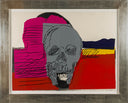About the Artist
Andy Warhol (1928–1987) remains one of the most influential figures in 20th-century art, a visionary who redefined the relationship between fine art and popular culture. While celebrated for his paintings, Warhol’s graphic works, his silkscreen prints and portfolios, constitute one of the most innovative and enduring facets of his career, offering collectors a direct connection to his fascination with celebrity, consumerism, and art history.
Warhol’s turn to printmaking in the 1960s coincided with his rise as the central figure of Pop Art. He embraced the silkscreen process not as a mechanical afterthought but as an artistic language in its own right. By harnessing repetition, bold color, and crisp graphic form, Warhol elevated the print portfolio into a primary medium, democratizing access to contemporary art while creating works of striking luxury and desirability. Institutions such as the Museum of Modern Art and the Whitney Museum of American Art continue to foreground Warhol’s prints as essential to understanding his legacy.
Among his most compelling series are those that engage with contemporary culture, art history, and myth-making:
- Mick Jagger (1975): These electrifying portraits combine Warhol’s screenprinted linework with hand-applied color, capturing both the energy of a rock icon and the intimacy of collaboration, Jagger himself signed each print alongside Warhol.
- Myths (1981): From Superman to Santa Claus, Warhol recast figures from mass culture as a pantheon of modern legends, blending irony with nostalgia in a portfolio that has become a collector’s favorite.
- Details of Renaissance Paintings (1984): Warhol juxtaposed classical imagery with contemporary printing techniques, reinterpreting masters like Leonardo da Vinci and Paolo Uccello with his signature vivid palette. The portfolio underscores his dialogue between tradition and modernity.
- Ads (1985): Warhol transformed commercial advertising into high art, reimagining corporate logos and campaigns like Volkswagen, Apple, and Chanel No. 5 as icons of modern life, revealing the poetry and power in branding.
- Cowboys and Indians (1986): One of Warhol’s final portfolios, this series examines American cultural identity by contrasting figures such as John Wayne with Native American leaders, critiquing myth while embracing imagery familiar to popular culture.
Warhol’s print portfolios are not merely editions; they are artworks that crystallize his philosophy of image-making in a medium perfectly suited to his time and ours. Their relevance has only grown in today’s market, where collectors seek works that combine cultural significance with graphic immediacy. The accessibility of multiples, coupled with their presence in every major museum collection, from Tate Modern to the Art Institute of Chicago, ensures that Warhol’s graphic works remain cornerstones of postwar art.
For the discerning collector, Warhol’s prints offer more than ownership of a celebrated name: they provide entry into an ongoing dialogue between art, commerce, and identity, one that continues to define contemporary culture.



















